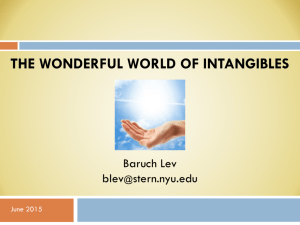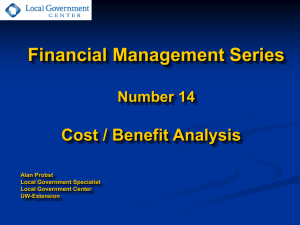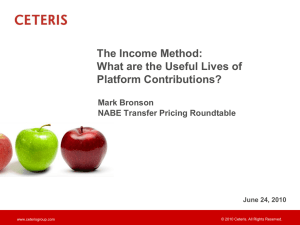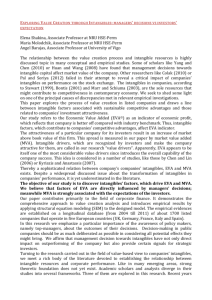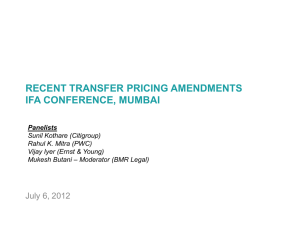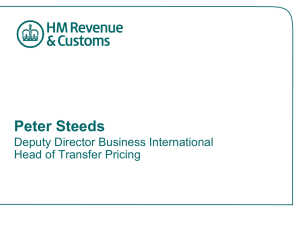Ferrara`s 10th Conference on Intangibles
advertisement
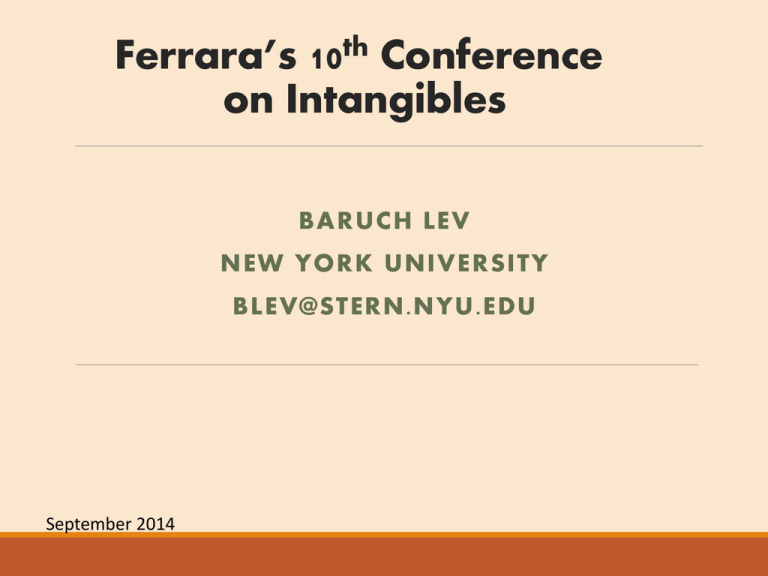
Ferrara’s 10th Conference on Intangibles BARUCH LEV NEW YORK UNIVERSITY BLEV@STERN.NYU.EDU September 2014 Characteristics of Conference Research (72 studies) Many studies on intellectual capital (intangibles) reporting by companies. Many studies on integrated, sustainability, triple bottom line reporting. Some studies on valuation of intangibles, mostly brands. Some studies on intangibles in the public and not-for-profit sectors. Some studies on intangibles at SMEs. Others Most studies very interesting, high quality 1 Majority of Research on IC Disclosure An old, 20−25 years research effort There have been lots of IC disclosure initiatives (NYU, Denmark) but most of them failed. IC reports mainly limited to some European companies; no standardization; very limited impact. By and large, leading corporations resist any meaningful intangibles disclosure. No incentives for managers, no real demand by investors. Sustainable, environmental, social, integrated reporting, all pushed by various organizations, but so far did not change the map (except in South Africa). Sorry for the grim report 2 Why the Failure? Fortune magazing conference of the “100 smartest people.” “Intangibles are inert, like bricks.” Inert: to be in a state of doing little or nothing. The only interest in intangibles per se, is when you try to sell them (patents, brands, software). Otherwise, what’s interesting to managers and investors is: how do the intangibles, with other resources, create value? This points at a different research agenda. This research agenda will be of great interest to managers, investors, and policymakers. How do I know? From hundreds of conference calls. 3 A New Research Agenda Useful to Managers, Investors, and Policymakers Focus on Strategic Resources, the drivers of long-term competitive advantage (see Resource-Based Theory) Strategic resources, mostly intangible (patents, brands) and some tangible (oil & gas resources, Amazon’s warehouses) are assets which: o Create economic value o Rare o Difficult for competitors to imitate. The research emphasis is on what interest managers, investors, and policymakers: o How best to create strategic resources o How to preserve and protect these resources o How to generate the most value from these resources. 4 Research: Creating Strategic Resources Is developing patents/products internally (R&D) more or less efficient than acquiring patents or development companies? Is outsourcing IT more efficient than maintaining an IT department inhouse? How effective are governments, or EU directives concerning minimum R&D? Is the number of company’s patents predictive of its future sales growth or share performance? (Many companies pay a bonus for patents granted.) Are the subsidies given by regional governments to science-based companies effective? What is the relationship between marketing & advertising expenses and brand values? 5 Research: Preserving Strategic Assets “Communities of practice.” The success of companies’ efforts to transform (codify) tacit to explicit knowledge. The battle against “organizational amnesia.” The effect of disruptive technologies on incumbent firms. Examples: ebooks on book publishers, internet on local newspapers, moocs (massive open online courses) on universities. The reinvention of bankrupt brands: Converse Allstar, Polaroid, Fiat 500, or the Mini Minor. Why some brands are resurrected while others are not. 6 Research: Creating Value with Strategic Assets Exploiting “Big Data” (see OECD, 2013 Intangibles report). Big data − the new factor of production (Brynjolfsson− 5-6% productivity increase). Create new goods and services, optimize production and delivery, enhance research and development. Netflix CEO: “80% of customer choices based on “recommendation algorithms.” At this early stage − good case studies will be an important contribution. Design − the new resource. OECD classify KBC to: computer software, computerized databases, R&D, creative property, brands, human capital, organizational structure, and design. Most popular course in Stanford business school. Design differentiates products (Apple, Sony). Contributes to the brand. Great research opportunities. Is Capitalized R&D an asset? Compare the valuation coefficient of expensed and capitalized R&D. 7 Research: Creating Value with Strategic Assets – Cont’d. Monetization of Intangibles o Licensing and sale of patents o Intangibles as loan collateral o Securitization of royalty streams (Bowie bonds) o Selling shares in patent pools (Deutsche Bank) Case Studies as well as large sample studies 8 Should I Do It? This is obviously a more demanding research agenda. You may have to access internal corporate records (big Data), learn from managers’ surveys, or identify specific databases (patent licensing). But the rewards are much higher than those of conventional research. o Improved publication prospects o Enhance your reputation (you’ll be cited) o Approached by companies and policymakers. Like in finance: higher risk − higher return. 9

